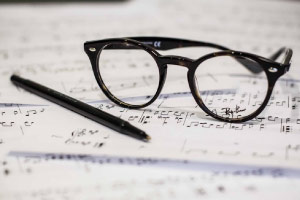Online courses directory (78)
If there was one century in the past that saw radical changes in established ways of thinking comparable to the 20th Century, it would be the 16th. Before this, in Western Europe, there was only one type of Christianity
With the failure of the French Revolution (Napoleon crowned himself Emperor, and after his defeat, a King was restored to power in France), there was a turn away from public, political life, toward personal, subjective experience. In large part, this turn characterizes the new style of Romanticism (don
The 17th Century is the era of the Baroque style, characterized by energy, drama, and movement. The Church in Rome needed art that spoke to its resurgent power even as the conflict between Protestant and Catholics continued. A new realism
This is a transitional period. In the art of Florence and Siena there is a move away from medieval abstract depictions of space and the human body as artists began to focus on the illusion of mass and space and the expression of human emotion. With hindsight, it is possible to trace elements of Renaissance art back to this period. This century saw the creation of the beautiful poetry of Dante and Petrarch, but it is also the century that saw the worst outbreak of the Bubonic plague (known then as the Black Death) which wiped out close to half the population of Europe
Augustus of Primaporta. Painted Garden, Villa of Livia. Head of Augustus. Sculpture from the Parthenon's East Pediment. Victory Stele of Naram-Sin. Ancient Greek Temples at Paestum, Italy. Dying Gaul. Ara Pacis. The Standard of Ur. Dionysiac frieze, Villa of Mysteries, Pompeii. East and West Pediments, Temple of Aphaia, Aegina. Colosseum. Myron, Discobolus (Discus Thrower), Roman copy of an ancient Greek bronze from c. 450 B.C.E.. Nike of Samothrace. Law Code Stele of King Hammurabi . The Pergamon Altar. Arch of Titus. Great Lyre from the "King's Grave" at Ur. Hadrian's Villa: A Virtual Tour. Parthenon Frieze. Maritime Theatre at Hadrian's Villa, Tivoli. Neo-Assyrian Art: Human Headed Winged Lion and Bull (Lamassu). The Parthenon: Metopes. Pair of Centaurs Fighting Cats of Prey from Hadrian's Villa. Mixing Vessel with Odysseus Escaping from the Cyclops' Cave. Erechtheion: Caryatid and Column. Column of Trajan. Ishtar Gate and Processional Way . Medea Sarcophagus, 140 - 150 C.E.. Equestrian Sculpture of Marcus Aurelius. Ludovisi Battle Sarcophagus. After Praxiteles, Venus (Roman Copy). Apollonius, Boxer at Rest, c. 100 B.C.E.. Nude Woman (Venus of Willendorf). Seated Scribe. Arch of Constantine. Digging Through Time. Thutmose's Bust of Nefertiti. House Altar with Akhenaten, Nefertiti and Three Daughters. Ramesses II. Alexander Mosaic. The Colossus of Constantine. Rosetta Stone. Hellenistic Art at the Metropolitan: Eros Sleeping and An Old Market Woman. Bodhisattva from China. Geometric Greek Krater. Exekias, Attic black figure amphora with Ajax and Achilles playing a game. Buddha of Medicine Bhaishajyaguru (Yaoshi fo). Polykleitos, Doryphoros (Spear-Bearer). Barberini Faun, c. 220 B.C.E.. New York Kouros. Japan, Muromachi to Momoyama period Negoro ware ewer. Ancient Rome. Temple of Portunus. The Pantheon, Rome.
Birth of the Gothic: Abbot Suger and the Ambulatory at St. Denis. Two Royal Figures (Saljuq Period). Last Judgment Tympanum, Cathedral of St. Lazare, Autun. Sutton Hoo Ship Burial. Virgin from Ger. Wise and Foolish Virgins, Sant Quirze de Pedret. Coronation Mantle. Sarcophagus of Junius Bassus. Basilica of Santa Prassede (Praxedes). Santa Sabina. Byzantine Art: Justinian and His Attendants. Historiated Capitals, Church of Sant Miquel, Camarasa (Noguera). Santa Maria Maggiore. Ivory panel with Archangel. Berlinghieri's St. Francis Altarpiece. Cathedral of Notre Dame de Chartres. Ilkhanid Mihrab. Hebrew Astrolabe. Pre-Columbian Cup.
An Introduction to Contemporary Art. Why is this Art? Andy Warhol, Campbell's Soup Cans. Art as Concept: In Advance of the Broken Arm. Why Is That Important? Looking at Jackson Pollock. Art & Context: Monet's Cliff Walk at Pourville and Malevich's White on White. Representation & Abstraction: Millais's Ophelia and Newman's Vir Heroicus Sublimis. Interpreting Contemporary Art. Big Questions in Modern & Contemporary Art. Matisse, Luxe, calme et volupt
This is the century that sees the full realization of the Renaissance and the end of the medieval way of thinking about the world. The Humanist rediscovery of ancient Greek and Roman culture is supported by the wealth accumulated in prosperous cities such as Bruges, Florence, and Venice. New wealth and increasing trade created a demand for an art based on the world we see. The second half of the century saw the invention of the printing press, and Columbus
New to art? If so, this is a good place to start. We often think we should understand what we see and that we know what we like, but art can be challenging. It has meant different things at different moments in history. Art gives us access to the way other people have seen the world. Jump in and explore!. A Beginner's Guide to the History of Western Culture. Common Questions about Dates. Why Look at Art?. The Skill of Describing. The Skill of Describing. The Classical Orders. How One-Point Linear Perspective Works. Art History Basics. Woodcuts and Etchings. Tempera Paint. Oil Paint. Oil Paint in Venice. Bronze Casting. Quarrying & Carving Marble. Art History - Media. A Beginner's Guide to the History of Western Culture. Common Questions about Dates. Why Look at Art?. The Skill of Describing. The Skill of Describing. The Classical Orders. How One-Point Linear Perspective Works. Art History Basics. Woodcuts and Etchings. Tempera Paint. Oil Paint. Oil Paint in Venice. Bronze Casting. Quarrying & Carving Marble. Art History - Media.
From the frivolous paintings of Fragonard to the politically-charged moralizing images of David, this tutorial brings us from the King of France and his court
The art of this period is familiar, since the world of the Realists, Impressionists and Post-Impressionists is much like our own. More and more people lived in cities and worked in factories or shops for wages. Scientific and technological advances increased dramatically during this period and although there was dislocation and privation, standards of living increased sharply. In essence, modern mass culture was born. Artists responded sometimes by embracing these radical changes, and at other times by resisting them. Key here is understanding the authority of the various art academies in Europe, which controlled matters related to taste and art, and which were, to some extent, always connected to the government. A small number of artists rebelled against the strictures of the academy, and against the demand for art to tell clear stories for a middle class audience, and formed what we know as the
The Art of Our Time. Bacon, Triptych - August 1972. Freud, Standing by the Rags. Diane Arbus, Boy with a Toy Hand Grenade. William Eggleston, Red Ceiling, or Greenwood, Mississippi, 1973. Ed Kienholz and Nancy Reddin Kienholz Useful Art #5: The Western Hotel, 1992. Warhol, Gold Marilyn Monroe. Warhol, Campbell's Soup Cans. Oldenburg, Floor Cake. Lichtenstein, Rouen Cathedral Set V. Gerhard Richter, Betty. Gerhard Richter, The Cage Paintings (1-6). Gerhard Richter, September. Donald Judd, Untitled. Dan Flavin, Untitled (To Donna) II. Smithson, Spiral Jetty. Hesse, Untitled. Hesse, Untitled (Rope Piece), 1970. Chicago, Pasadena Lifesaver, Blue Series, No. 4 & Benglis, Omega. Winsor, #1 Rope. Joseph Beuys, Table with Accumulator. John Baldessari, I Will Not Make Any More Boring Art. Hans Haacke's Seurat's 'Les Poseuses' (small version). Interpreting Contemporary Art. Colescott, Beauty is in the Eye of the Beholder. Sherman, Untitled Film Still #21. Sherrie Levine, Untitled (After Edward Weston, ca. 1925). The Art of Our Time. Bacon, Triptych - August 1972. Freud, Standing by the Rags. Diane Arbus, Boy with a Toy Hand Grenade. William Eggleston, Red Ceiling, or Greenwood, Mississippi, 1973. Ed Kienholz and Nancy Reddin Kienholz Useful Art #5: The Western Hotel, 1992. Warhol, Gold Marilyn Monroe. Warhol, Campbell's Soup Cans. Oldenburg, Floor Cake. Lichtenstein, Rouen Cathedral Set V. Gerhard Richter, Betty. Gerhard Richter, The Cage Paintings (1-6). Gerhard Richter, September. Donald Judd, Untitled. Dan Flavin, Untitled (To Donna) II. Smithson, Spiral Jetty. Hesse, Untitled. Hesse, Untitled (Rope Piece), 1970. Chicago, Pasadena Lifesaver, Blue Series, No. 4 & Benglis, Omega. Winsor, #1 Rope. Joseph Beuys, Table with Accumulator. John Baldessari, I Will Not Make Any More Boring Art. Hans Haacke's Seurat's 'Les Poseuses' (small version). Interpreting Contemporary Art. Colescott, Beauty is in the Eye of the Beholder. Sherman, Untitled Film Still #21. Sherrie Levine, Untitled (After Edward Weston, ca. 1925).
Were the Middle Ages really all that dark? Hardly! How could we call the period that saw the building of Chartres Cathedral with its stunning stained-glass windows, dark? Sure, the Roman empire collapsed, but with the Christianization of Europe came magnificent churches, illuminated bibles, and intricately designed broaches. This period also saw the birth of Islam, the third great monotheistic religion. Introduction. Medieval and Byzantine Art. A New Pictorial Language: The Image in Early Medieval Art. Iconoclasm. Medieval Manuscripts. The Bestiary. Beginner's Guide to Medieval Art. An Introduction to Christianity. Standard Scenes from the Life of Christ in Art. An Introduction to Early Christian Art. Early Christian Art & Architecture after Constantine. Sarcophagus of Junius Bassus. Santa Sabina. Santa Maria Maggiore. The Mausoleum of Galla Placidia, Ravenna. Early Christian. Sutton Hoo Ship Burial. The Lindesfarne Gospels. Medieval and Byzantine Art. San Vitale. Sant'Apollinare in Classe, Ravenna, Italy, c. 533-49. Hagia Sophia. Ivory panel with Archangel. Icon of Saint George (the "Black George"). Icon of the Triumph of Orthodoxy. Byzantine Art. Introduction to Islam. The Five Pillars of Islam. Arts of the Islamic World. Two Royal Figures (Saljuq Period). Coronation Mantle. Ilkhanid Mihrab. Hebrew Astrolabe. Qa'a: The Damascus Room. Carolingian Art: An Introduction. Charlemagne: An Introduction (1 of 2). Charlemagne and the Carolingian Revival (part 2 of 2). Saint Matthew from the Ebbo Gospel. Lindau Gospels Cover. Santa Prassede (Praxedes). Carolingian. Ottonian Art: An Introduction. Bronze doors, Saint Michael's, Hildesheim, commissioned by Bishop Bernward, 1015. Pilgrimage Routes and the Cult of the Relic. Pentecost and Mission to the Apostles Tympanum, V
Humans have been making art for tens of thousands of years, long before there was writing. Why was Egyptian art obsessed with death? Why did the ancient Greeks seek the perfect human form? How did the ancient Romans use art as state propaganda? Why was the naturalism of ancient Greek and Roman art abandoned with the rise of Christianity? This topic explores the art of the ancient world, from the Venus of Willendorf to a 6th-Century Chinese Bodhisattva. Prehistoric Art: Paleolithic Origins. Nude Woman (Venus of Willendorf). The Neolithic Revolution. Jade Cong. Prehistory: Proto-writing. Prehistoric Art Quiz. Introduction. Ancient History: The Alphabet. Sumerian Art: Standard of Ur. Sumerian Art: Great Lyre from the "King's Grave" at Ur. Akkadian Art: Victory Stele of Naram-Sin. Babylonian Art: Law Code Stele of King Hammurabi. Ashurbanipal Hunting Lions (Assyrian). Assyrian Art: Human Headed Winged Lion and Bull (Lamassu). Neo-Babylonian Art: Ishtar Gate and Processional Way. Ancient Near Eastern Art. Introduction. Egyptian Art. Materials & Techniques. Ancient Near Eastern & Ancient Egyptian Art. Old Kingdom: Seated Scribe. New Kingdom: House Altar with Akhenaten, Nefertiti and Three Daughters. Portrait Head of Queen Tiye with a Crown of Two Feathers. New Kingdom: Thutmose's Bust of Nefertiti. Judgement in the Presence of Osiris, Hunefer's Book of the Dead. New Kingdom: Ramesses II. Ptolemaic: Rosetta Stone. Ancient Egypt. Ancient Greece and Rome. Ancient Greek and Roman Art. Geometric: Terracotta Krater. Archaic: Exekias, Attic black figure amphora with Ajax and Achilles playing a game. Archaic: Exekias, Dionysos Kylix, c. 530 B.C.E.. Archaic: Mixing Vessel with Odysseus Escaping from the Cyclops's Cave. Archaic: New York Kouros. The Classical Orders. Archaic and Early Classical: Ancient Greek Temples at Paestum, Italy. Archaic and Early Classical: East and West Pediments, Temple of Aphaia, Aegina. Early Classical: Polykleitos, Doryphoros (Spear-Bearer). Classical: Myron, Discobolus (Discus Thrower), Roman copy of an ancient Greek bronze. Classical: Parthenon Frieze. Classical: Sculpture from the Parthenon's East Pediment. Classical: Parthenon Metopes. Classical: Caryatid and Column from the Erechtheion. Late Classical: Lysippos, Farnese Hercules, 4th century B.C.E. (later Roman copy by Glycon). Late Classical: Lysippos, Apoxyomenos (Scraper), c. 330 B.C.E. (Roman copy). Late Classical: After Praxiteles, Venus (Roman Copy). Hellenistic: Barberini Faun. Hellenistic: Dying Gaul. Hellenistic: Nike of Samothrace. Hellenistic: The Pergamon Altar. Hellenistic: Apollonius, Boxer at Rest. Hellenistic: Alexander Mosaic. Hellenistic: Laoco
Graphic designers, artists, photographers and all those involved in the visual arts need an accurate understanding of colour theory. This free online course from ALISON presents aspects of colour and light perception such as hue, lightness and chroma, brightness and saturation, visual perception of colour, mixing paints, and additive and subtractive colour mixing. The comprehensive text is accompanied by interactive graphics that further explain the concepts. This course is ideal for any learner who practices the visual arts, either professionally or as a hobby, and who wants to greatly enhance their knowledge and understanding of colour theory.
Got Ants? Let me show you how you can CONTROL ants, keep em out of places you don't want them to be in.
Music theory, one of our top online music classes, is the analysation of how music works - by studying the notation and language of music. Unlike other online music lessons, Introduction to Music Theory introduces the basic concepts and terms needed to discuss melody and harmony. Concepts covered include interval, major and minor keys and scales, triads, chords and beginning harmonic analysis.<br />The course is suitable for teens or adults with no background in music theory but some familiarity with reading common notation and playing an instrument (or singing).<br />
A basic level survey of painting, sculpture, and architecture.
This Graphic Design course builds on the introductory course and investigates the application of graphic design principals in the production process such as composition, balance, contrast and hierarchy. It is suitable for students studying graphic design, and designers and artists working in the graphic design industry. <br />
A clear concise history of art since Prehistory until the beginnings of the Italian Renaissance,
Trusted paper writing service WriteMyPaper.Today will write the papers of any difficulty.

















